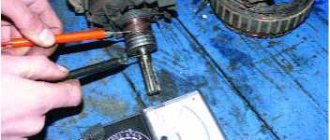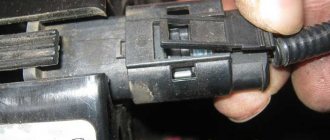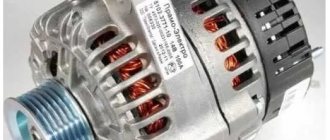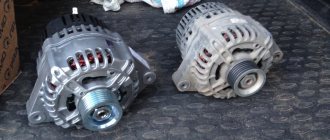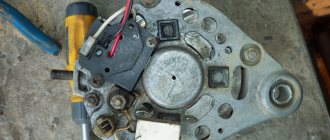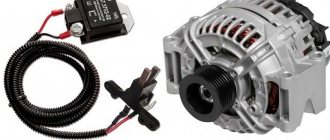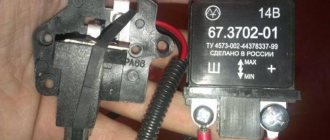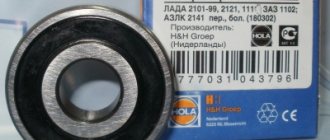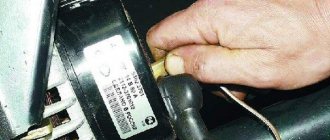A car generator howls, reasons
Let’s determine the causes of the malfunction “the generator howls” and try to find out on our own what exactly happened. Let's do all this using the example of the standard generator 37.3701 of a VAZ 2109 (2108, 21099).
Symptoms of a problem
Constant or periodic “howling” (high-pitched sound) from the car’s generator.
Disappearance of charging (either complete or decreased). The battery charge lamp on the instrument panel is on or blinking.
A car generator howls, causes of malfunction
The main reason is a short circuit of the stator windings to ground.
Without removing the generator from the engine, you can independently diagnose this malfunction only together with its other malfunctions. This can be done this way: turn on powerful consumers (stove, headlights), set the speed within 3000 rpm and measure the voltage at the battery terminals. There must be at least 13 V.
If less, the generator is faulty. But, there may still be a problem with the voltage regulator, rotor windings, diode bridge, and not just with the stator windings.
Therefore, in order to accurately establish that the stator windings are shorted to ground, you need to remove the generator from the engine. Take it apart. And using a multimeter in ohmmeter mode, check for the presence of a short circuit.
See photo at the beginning of the article.
We press the negative probe of the multimeter in ohmmeter mode to the stator, and the positive probe to any winding terminal. If there is no short circuit, the resistance on the device tends to infinity. We repeat the operation for each winding terminal.
If you do not have a multimeter, you can use a test lamp to check the generator stator winding for a short circuit.
When checking the generator stator for a short circuit with a test lamp, we apply a minus from the battery terminal to the stator, and a plus to the test lamp. With the other terminal of the lamp we touch any terminal of the winding. The lamp lights up - there is a short circuit, no - everything is normal. We repeat the procedure for each output.
In this simple way, you can determine the malfunction of the stator windings of the generator and find out the reason for its “howling”. A failed generator stator needs to be replaced.
Notes and additions
Along the way, you can check the generator stator windings for an open circuit.
We press the multimeter probes in ohmmeter mode to the terminals of the stator winding. If there is no “break”, the device will show a resistance within 10 ohms. If there is a “break” in the stator windings, that is, no current passes through them, then the resistance tends to infinity. In this way, we check all three conclusions in turn.
In some cases, a weakly tensioned alternator belt may “howl.” To accurately diagnose the problem, it is recommended to remove the belt and listen to the operation of the generator. If necessary, adjust its tension and/or replace it with a new one.
Source
Types of welding generators and their malfunctions
A welding generator is a multifunctional device that can simultaneously be used to generate electricity and as a source of a welding arc. The service workshop for the repair of construction equipment Alfa-Rost in Rostov-on-Don offers services for repairing and troubleshooting welding generators of any manufacturer at low prices. Welding generators according to the type of fuel used are divided into:
- gas;
- diesel;
- gasoline.
A welding generator is indispensable for working in conditions where there is no constant uninterrupted power supply.
Despite the fact that the welding generator has a high degree of reliability, its possible failure can be due to a variety of reasons, such as: contamination of the commutator, poor contact in the excitation circuit, increased load, break in the armature winding, uneven distribution of current between the brushes, traverse shift. The welding generator consists of an engine and a generator; its malfunctions are of two types:
- engine malfunction;
- generator malfunction.
In order to repair welding generators, you need the help of experienced specialists. In this article we will consider possible malfunctions of welding generators, the reasons for their occurrence and options for solving the problem.
Howl from the VAZ 2114 generator
- Registration
- Entrance
- To the beginning of the forum
- Forum Rules
- Old design
- FAQ
- Search
- Users
Good day, gentlemen!
The other day I started 21103 and there was a strange howl (not from the engine), but from the generator. Later I noticed that at speeds less than 1000, the battery light comes on (i.e. there is no charging).
How to solve the generator whine problem? The belt is tensioned as expected
hmmm, I'll have to look at what and how this weekend
I'll keep driving like this for now
Why does the generator hum in a car?
This question is often asked on forums. Why does the alternator on a car hum and stop doing so as soon as the terminal is disconnected from the battery? At the same time, the more electricity consumers are connected to the car, the louder it can buzz. As for the voltage, it shows 14.05V without additional consumers, however, as the car accelerates, the voltage drops to 12.3.
Troubleshooting
On modern cars, using the “old-fashioned” diagnostic method by removing it from the battery terminal can lead to serious damage to many of the car’s electronic systems. Significant voltage drops in the vehicle's on-board network can damage almost all on-board electronics. That is why modern generators are always checked only by measuring the voltage in the network or diagnosing the removed unit itself on a special stand. First, the voltage is measured at the battery terminals, the engine is started, and readings are taken while the engine is running. Before starting, the voltage should be about 12 V, after starting - from 13.8 to 14.7 V. A deviation towards the higher side indicates that you are “overcharging”, which implies a malfunction of the relay regulator, and towards a lower level - that no current is flowing. The absence of recharging current indicates a malfunction of the generator or circuits.
Bearings
First of all, experts see the reason in the bearing. Apart from him, there is nothing to hum there. Although in some cases the diode bridge may also produce a hum. You should know that the more consumers are involved in the car, the more difficult it is for the generator to turn. The load on the bearings automatically increases.
As you know, generator bearings are installed for easy rotation of the rotor armature. One of the bearings is placed in the front cover, the other is pressed onto the rotor. It is noteworthy that both bearings are pressed, so replacing them is not so easy.
As a rule, if the bearings fail, then in addition to the hum, the battery is no longer charged.
Experts recommend paying attention to the nature of the hum. If it resembles a whistle and is heard mainly under the hood, then the bearing is definitely worn out.
Before replacing bearings, you should find out what brand they are. If they are domestically produced, they are inexpensive. The price of imported spare parts is much higher.
The service charges at least 600-700 rubles for the work of replacing bearings. But this can be done with your own hands.
Replacement is carried out as follows:
- the car engine turns off;
- the belt is removed;
- the wiring is dismantled, the generator is unscrewed and removed;
- disassembling the generator begins with removing the rear plastic cover;
- brushes and relays are removed;
- the diode bridge is dismantled, which should be freed from 3 screws;
- Next, the front part is disassembled, the rotor is carefully clamped in a vice, and the pulley is removed;
- the front cover with the bearing is removed;
- the rear bearing is pressed from the armature (a puller is used).
Self-test of the generator
The easiest way is to check the fuse. If it is in good condition, the generator and its location are inspected. The free rotation of the rotor, the integrity of the belt, wires, and housing are checked. If nothing arouses suspicion, the brushes and slip rings are checked. During operation, the brushes inevitably wear out, they can become jammed, skewed, and the grooves of the slip rings become clogged with graphite dust. A clear sign of this is excessive sparking.
There are frequent cases of complete wear or failure of both bearings and stator failure.
The most common mechanical problem with a generator is bearing wear. A sign of this malfunction is a howling or whistling sound when the unit is operating. Of course, the bearings must be replaced immediately, after first inspecting the seats. Loose drive belt tension can also cause poor generator performance. One of the signs may be a high-pitched whistle from under the hood when the car accelerates or accelerates.
To check the rotor field winding for short-circuited turns or breaks, you need to connect a multimeter, switched to resistance measurement mode, to both contact rings of the generator. Normal resistance is from 1.8 to 5 ohms. The readings below indicate the presence of a short circuit in the turns; above – direct winding break.
To check the stator windings for ground fault, they need to be disconnected from the rectifier unit. If the resistance readings given by the multimeter are infinitely large, there is no doubt that there is no contact between the stator windings and the housing (“ground”).
To check the diodes in the rectifier block, use a multimeter (after completely disconnecting it from the stator windings). The test mode is “diode test”. The positive probe is connected to the plus or minus of the rectifier, and the negative probe is connected to the phase terminal. After this, the probes are swapped. If the values of the multimeter readings differ greatly from the previous ones, the diode is working; if they do not differ, it is faulty. Another sign indicating the imminent “death” of the generator diode bridge is oxidation of the contacts, and the reason for this is overheating of the radiator.
Diode bridge
The hum can also come from the diode bridge. To check whether the diode bridge is shorting, you should remove the cover on the back of the unit, remove the diode bridge, and adjust the washers under the clamps with which it is screwed. And if you add an additional puck, it will be even better.
It also happens that a wire falls off the diode bridge. It’s a banal reason, but until you figure it out, you won’t see it.
Video “How to properly disassemble and reassemble a unit with your own hands”
Instructions for disassembling and reassembling the generator unit for a VAZ are presented in the video below (the author of the video is Denis Legostaev).
1200 rub. for the photo report
We pay for photo reports on car repairs. Earnings from 10,000 rubles/month.
Write:
Malfunctions of vehicle electrical equipment are very common and occupy one of the leading places in the list of breakdowns. They can be roughly divided into faults of power sources (batteries, generators) and faults of consumers (optics, ignition, climate, etc.). The main sources of power for a vehicle are batteries and generators . The malfunction of each of them leads to a general malfunction of the car and its operation in abnormal modes, or even to immobilization of the car.
In the electrical equipment of a car, the battery and generator work in an inextricable tandem. If one fails, after a while the other will also fail. For example, a damaged battery leads to an increase in the charging current of the generator. And this entails a malfunction of the rectifier (diode bridge). In turn, if the voltage regulator supplied from the generator malfunctions, the charging current may increase, which will inevitably lead to systematic recharging of the battery, “boil-off” of the electrolyte and rapid destruction.
Other reasons
The noise can also come from a broken seat and a worn shaft.
Of course, the generator can also make noise due to a short circuit.
The timing belt may hum, and the owner may think it is a generator. In this case, you need to remove the belt and listen - if the noise disappears, then it was the belt.
For many Russian drivers, the generator begins to hum after heavy rain. This means that water gets inside the unit, and until you disassemble the element and clean everything inside, nothing will help.
And of course, a relay or integral. Brushes cost pennies, so to check, it is advisable to change them first. Then listen to see if there is a hum.
Thus, the generator can hum for various reasons, but the most common are: bearing failure, a short circuit in the diode bridge, or a wire falling off.
Source
Transformer testing and troubleshooting
Diagnostics will help identify the cause of the problem and eliminate the malfunction. Interturn closure is determined by external inspection. If damage to the insulating layer and dark marks on the winding are observed, this indicates the specified problem.
In this case, the device needs to rewind the coils.
If the external examination does not produce results, a more in-depth study will be required.
If you have a multimeter, you can do the following:
- In megohmmeter mode, insulation resistance measurements are taken and compared with the standard values given in the reference literature. If the actual value exceeds the nominal value by more than 50 percent, this indicates the presence of an interturn short circuit;
- A similar measurement is carried out for a technically sound device. A discrepancy of more than 20 percent indicates a malfunction.
Also read: Transformer no-load mode
When studying a step-down device, you can measure the voltage value for the output winding by connecting the device to the network. If smoke or crackling appears when turned on, the device should be turned off immediately - this indicates a failure of the primary coil.
Often a self-rewinding transformer begins to hum. This happens for the following reasons:
- the core is incorrectly assembled or not tightly fitted - it should be arranged tightly, check the tightness of the connection of the plates;
- the winding is not secured enough - the coil needs to be strengthened;
- gaps between the turns of the winding - the coil is impregnated with paraffin, filling the gaps;
- The number of turns is incorrectly calculated - rewinding will have to be done again.
In order for the transformer to work correctly after repair, the work must be performed by a professional. If you do not have the appropriate knowledge, skills and experience, you should not interfere with the device.
If a strong hum appears during operation of the transformer, it is necessary to carry out diagnostics. Otherwise, continued use of the device may result in failure, jeopardizing the safe operation of other equipment.
Why does a car generator howl?
Let’s determine the causes of the malfunction “the generator howls” and try to find out on our own what exactly happened. Let's do all this using the example of the standard generator 37.3701 of a VAZ 2109 (2108, 21099).
Symptoms of a problem
Constant or periodic “howling” (high-pitched sound) from the car’s generator.
Disappearance of charging (either complete or decreased). The battery charge lamp on the instrument panel is on or blinking.
Why does a car generator howl?
The main reason is a short circuit of the stator windings to ground.
Without removing the generator from the engine, you can independently diagnose this malfunction only together with its other malfunctions. This can be done this way: turn on powerful consumers (stove, headlights), set the speed within 3000 rpm and measure the voltage at the battery terminals. There must be at least 13 V.
If less, the generator is faulty. But, there may still be a problem with the voltage regulator, rotor windings, diode bridge, and not just with the stator windings.
Therefore, in order to accurately establish that the stator windings are shorted to ground, you need to remove the generator from the engine. Take it apart. And using a multimeter in ohmmeter mode, check for the presence of a short circuit.
We press the negative probe of the multimeter in ohmmeter mode to the stator, and the positive probe to any winding terminal. If there is no short circuit, the resistance on the device tends to infinity. We repeat the operation for each winding terminal.
If you do not have a multimeter, you can use a test lamp to check the generator stator winding for a short circuit.
When checking the generator stator for a short circuit with a test lamp, we apply a minus from the battery terminal to the stator, and a plus to the test lamp. With the other terminal of the lamp we touch any terminal of the winding. The lamp lights up - there is a short circuit, no - everything is normal. We repeat the procedure for each output.
Types of generator faults
Due to the fact that any generator is an electromechanical device, there will be two types of faults - mechanical and electrical.
The first includes the destruction of fasteners, housing, malfunction of bearings, pressure springs, belt drive and other failures not related to the electrical part.
Electrical faults include winding breaks, diode bridge faults, brush burnout/wear, turn-to-turn short circuits, breakdowns, rotor beating, and relay-regulator faults.
Often, symptoms that indicate characteristics of a faulty generator can also appear as a result of completely different problems. As an example, poor contact in the fuse socket of the generator field winding circuit will indicate a generator malfunction. The same suspicion may arise due to burnt contacts in the ignition switch housing. Also, the constant lighting of the generator malfunction indicator lamp can be caused by a breakdown of the relay; the blinking of this switching lamp may indicate a generator malfunction.
The main signs of a malfunctioning autogenerator:
- When the engine is running, the battery discharge warning lamp flashes (or stays on continuously).
- Discharging or overcharging (boiling) of the battery.
- Dim car headlights, a rattling or quiet beep when the engine is running.
- Significant change in headlight brightness with increasing speed. This may be acceptable when increasing the speed (re-throttle) from idle, but the headlights, having lit up brightly, should not increase their brightness any further, remaining at the same intensity.
- Extraneous sounds (howling, squeaking) coming from the generator.
It is necessary to regularly monitor the tension and general condition of the drive belt. In case of cracks and delaminations, immediate replacement is necessary.
